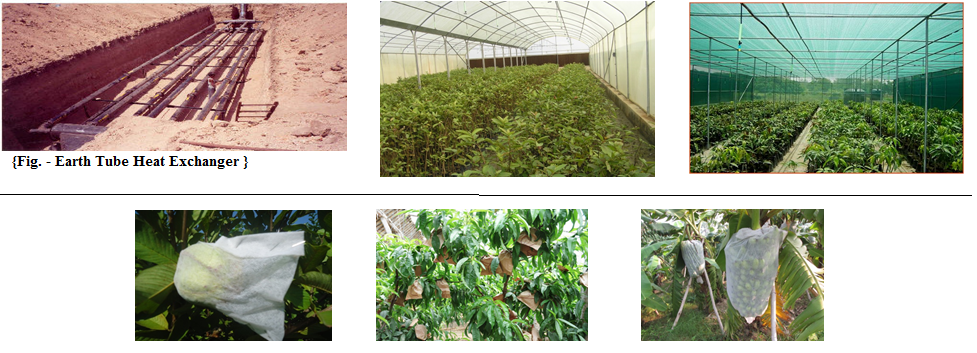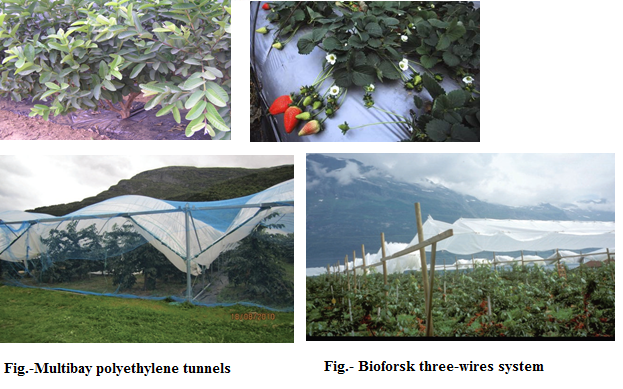Authors: Praveen Kumar Mishra1* and Sanjay Sahay2
praveen.bau@gmail.com*
1 Ph. D. Scholar*
2 Associate Professor cum Senior Scientist
Department of Horticulture (Fruit & Fruit Technology), B.A.U., Sabour, Bhagalpur, Bihar, India, 813210.
Introduction
Protected cultivation (PC) is most intensive agricultural production systems to minimise the chemical, pesticides residue in pomological produce and accelerate R&D with climate change and changing cropping pattern. PC is proving as a boon for marginal and small growers with limited land and water resources. Greenhouses were first introduced in India during 1960’s for research purpose and commercial cultivation started in 1988. Protected cultivation / green-house/low poly tunnels production techniques are now available for growing selected fruit crops like strawberry to obtaining high quality fruits and it also helps in off season fruits production round the year. Low cost greenhouse technology developed for high quality fruit production in hilly states of J & K, Himachal Pradesh, Uttaranchal and North Eastern states. These structures are now used commercially for export of quality fruit production in plains of Maharashtra & Karnataka. The farmers of this zone have shifted to protected cultivation of another fruit crops including strawberry, grape, cherry, apricot, and plum to save their livelihoods. Recent estimates for the peach and nectarine segment of the protected cultivation industry in China suggest that approximately 80% is nectarine while 20% is peach. Therefore, accepting change and getting in tune with nature by following scientific mitigation and adaptation strategies seem to be the key for survival and prosperity of mountain as well as other region farmers.
Greenhouses structures and designs
Green houses are framed or inflated structures covered with plastic material or glass in which crops can be grown under partially controlled environment which is large enough to permit normal cultural operation manually. Green house technology was well adapted in Europe and USA by the end of the nineteenth century. Presently, China and Japan are the leading countries. Other countries where green house technology is being widely used are Netherlands, Israel, Canada, Spain and Egypt besides some Arab countries. Green houses are suitable for growing a variety of fruits and throughout year cultivation even under extreme climatic conditions is possible through green houses. Seedlings and cuttings preparation time is also reduced significantly with the application of green house technology.
India has varied climatic conditions in different regions, so the greenhouse and the supporting facilities have to be developed accordingly. The southern plateau will have mild climate and coastal regions need only naturally ventilated poly houses. The northern plains with extreme hot and cold climate need the cooling and heating facilities. The local climatic conditions play a major role in design of the greenhouse structures and cladding materials. Under mild and hot climates, single film cladding of 200 micron thick UV stabilized LDPE film will be sufficient, while for cold climates inflated double layer of UV stabilized LDPE film is required. The initial cost of the greenhouse generally depends upon the cost of structure, cladding and temperature control mechanism. The fan and pad greenhouses are cooling type and are suitable for high temperature and low humidity (for northern plains). In naturally ventilated greenhouse, the temperature is maintained 1 to 30C above ambient conditions due to wind and thermal resilience and here no need of any electric power for maintenance of temperature and R.H. Under Indian conditions naturally ventilated greenhouse are most suitable due to low operating costs. The naturally ventilated greenhouses are also economical for cultivation in northern hilly regions during summer
Strategies for accelerating production
• Regular uninterrupted power supply
• Government support to establishment of protected structures
• Proper market linkages/ market intelligence and cool chain
• Developing multi-storied vertical farms near the peri-urban localities
Protected Cultivation Technologies
The several technologies like high tunnels, mulching, bagging, drip fertigation, net houses, raise bed and Earth Tube Heat Exchanger (ETHE) for hot humid areas are help to successful fruit production and plant multiplication.
• Drip fertigation
• Raised beds
• Mulching
• Tunnels : plastic covered and insect screen covered
• Net-houses : Shade nets (Intensity & color) and insect-proof nets (Porosity) Protection against animals, birds, excessive radiation, wind and hails
• Greenhouses, Mist chambers etc.
• IPM in Greenhouse
Role of protected cultivation
• Uniform and better quality production and fresh fruits availability
• Higher productivity
• Weed free cultivation
• Efficient use of resources
• Regulate harvesting time to reduced post-harvest losses {Fig. - Earth Tube Heat Exchanger }
• Round the year as well as off-season cultivation is possible in hostile climates
• Better insect pest and disease control with lesser use of pesticides
• Employment generation from small holdings
• Create micro-climate for optimum plant performance
• Check the losses from natural calamities
• Conservation of biodiversity
• Breeding for resistance to abiotic stresses
Nursery management
Greenhouse is also essential for plant propagation through tissue culture. Considering the advantages of greenhouse, there is ample scope for encouraging area under protected cultivation of high value fruit crops out of season, both in the temperate and tropical climate. However, profitability in green house cultivation will depend upon the choice of green house structure, selection of crops and varieties and production technologies adopted. While the conventional green houses are simple structures, the hi-tech green houses have facilities for controlling light intensity, temperature, humidity with complete automation of the system. This technology has potential of increasing yield by 300 percent coupled with quality, it needs to be encouraged. With boom in retail sector of horticulture in India, there is a growing demand for high quality, specialty produce and thus protected cultivation will be playing a major role to meet the demand of specific variety of fruits.

Bagging/ Bunch covering
Bagging of fruit at pre-harvest are also being used to protect the plant from insect infestation, improved quality in terms of appearance & size of fruits and the increased the yield in various fruit crops
Mulching
Covering of soil around the root zone of plant with an organic or artificially produce covering materials are called mulching. It is an effective means to restrict weed growth, conserve moisture and reduce the effect of soil borne diseases through soil solarisation. The use of black mulch has been found beneficial in mango, citrus, ber and apple. It also helps in improvement of soil structure increase in micro-activity, earthworm populations and more extensive root systems.
Integrated Pest Management
The purpose of growing crops under greenhouse conditions is to extend their cropping season and to protect them from adverse environmental conditions, such as extreme temperatures and precipitation, and from diseases and pests. Greenhouse structures are essentially light scaffolding covered by sheet glass, fibreglass or plastic. Generally, added-value crops are grown under protection. Quality is a high priority for greenhouse crops, requiring much care in pest and disease management, not only to secure yields but also to obtain a high cosmetic standard.

Avoid fruit cracking
Fruit cracking is the result of morphological, physiological, environmental and genetic factors. Several advances in the use of different cultural practices, which reduce fruit cracking have however been made. These practices include exclusion of water from the fruit surface during growth and maturation of the fruit using plastic rain covers and reducing osmotic potential across the fruit skins during rainfall events using calcium products.
Mulching
Covering of soil around the root zone of plant with an organic or artificially produce covering materials are called mulching. It is an effective means to restrict weed growth, conserve moisture and reduce the effect of soil borne diseases through soil solarisation. The use of black mulch has been found beneficial in mango, citrus, ber and apple. It also helps in improvement of soil structure increase in micro-activity, earthworm populations and more extensive root systems.
Integrated Pest Management
The purpose of growing crops under greenhouse conditions is to extend their cropping season and to protect them from adverse environmental conditions, such as extreme temperatures and precipitation, and from diseases and pests. Greenhouse structures are essentially light scaffolding covered by sheet glass, fibreglass or plastic. Generally, added-value crops are grown under protection. Quality is a high priority for greenhouse crops, requiring much care in pest and disease management, not only to secure yields but also to obtain a high cosmetic standard.
Avoid fruit cracking
Fruit cracking is the result of morphological, physiological, environmental and genetic factors. Several advances in the use of different cultural practices, which reduce fruit cracking have however been made. These practices include exclusion of water from the fruit surface during growth and maturation of the fruit using plastic rain covers and reducing osmotic potential across the fruit skins during rainfall events using calcium products.
Limitations of protected cultivation
• High cost of initial installation
• Non-availability of various components
• Needs a special postharvest facility
Thrust area of research
PC is play vital role in quality fruit production and productivity and it will make essential in coming time. That is why research on linked issues of PC should also compulsory to obtain more production and productivity and can able to fulfil the need of growing population. The following heads are given below in light of research.
• Need to develop high-yielding varieties
• Dire need of trained manpower
• Standardization of agro technique for individual crop
• Location-specific protected structure transfer to the farmers.
• Automation and crop modeling still in infancy
• Research on media, fertigation, IPM/IDM etc.
• Development and supply of quality planting materials
• suitable crop sequences and seasons based research
• Selection and promotion of suitable design of protected structures
References:
1. Amani, M. and Avagyan, G. (2014). Effect of polyethylene bunch cover on fungal diseases control of banana (Musa acuminate L.) in Iran. International Journal of Farming and Allied Sciences, 3 (10): 1054-1057.
2. Coneva, E. (2010). Choosing a Fruit Crop for High Tunnel Production. Horticulture series timely information Agriculture & Natural Resources, 1-2.
3. Layne, D. R., Wang, Z. and Niu, L. (2012). Protected Cultivation of Peach and Nectarine in China â€" Industry Status And Opportunities For The Early Market. XXII Congresso de Fruticultura Bento Goncalves-RS 22 a 26 de outubro de.
4. Meland, M., Kaiser, C. and Christensen, J. M. (2014). Physical and Chemical Method to Avoid Fruit Cracking in Cherry. AgroLife Scientific Journal, 3(1):177-183.
Wang, Z.Q. and Niu, L. (2012). Peach industry status and recommendations. Peach Growers’ Friend (in Chinese). In press
About Author / Additional Info:
Ph. D. Scholar in Fruit Science at BAU Sabour, Bhagalpur, Bihar